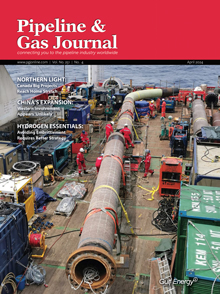November 2011, Vol. 238 No. 11
Features
Oil And Gas Industry Assess Outlook Amid Global Changes

The focus of the report is on investment prospects, the changing risk environment and the new industry dynamic, whereby international oil companies and national oil companies are redefining their relationships in developing conventional and unconventional hydrocarbons assets. The research drew on two main initiatives including a global survey of senior executives. In total, 194 executives took part, representing a cross-section of firms in the oil and gas industry. These executives were very senior: one in three respondents were CEOs or managing directors, while all hailed from management positions. They represent firms ranging in size from less than US$500 million in revenue (39%) to more than US$5 billion (35%). To supplement the survey results, in-depth interviews were conducted with numerous executives, including CEOs, divisional heads, senior lobbyists and policymakers. The report notes that the oil and gas industry has come through a period of unprecedented price volatility, with record prices followed by a crash and then a slow recovery. Asked to look ahead, industry executives surveyed and interviewed by the Economist Intelligence Unit see investment opportunities during a period of relative price stability, especially in the fast-growth economies in Asia. The technological advantages enjoyed by some of the international oil and gas companies give them leverage to develop resources in some of the most challenging environments, such as the deepwater offshore, and to open up previously unavailable reserves, such as unconventional gas, for which demand is rising as utilities look for a relatively low-carbon, cost-effective “transition” fuel to meet CO-2 reduction goals. However, there are enormous challenges for the industry ahead. The report says the Deepwater Horizon disaster at BP’s Macondo oilfield in the Gulf of Mexico has many recalculating the risks the industry faces as it pressed into these new frontiers of oil and gas development. It also notes that after the pressure on the U.S. government during that six-month gusher, there is a new attitude to oversight in the industry in the U.S. and elsewhere. This may lead to higher costs for industry and restrict the opportunities to those who can afford it. There is also closer scrutiny of the environmental impact of unconventional gas, which requires techniques to access that are still not fully understood. In the meantime, international oil companies (IOCs) must navigate increasingly complex relationships with national oil companies (NOCs), both from the resource-rich countries and with those representing the interests of the emerging economies. The sections below cover these pressing issues and discuss some of the industry’s responses. Key findings emerging from the research include the following: Investment Plans Spending Opportunities North America is the next significant region, identified by 30% of respondents. Prices Asian demand is expected gradually to erode the oversupply and bring prices back up to a level that makes investment attractive. Indeed, far more executives expect prices to increase in the coming year than those who feel it might decline. In any case, natural gas represents the most interesting narrative in this report, with new extraction and distribution technology leading to a significant rise in the share of gas in the future energy mix. As noted in the report, global demand for LNG has grown as countries in Asia and Europe have sought to increase their supply options. The emergence of large reserves of “unconventional” gas in North America has proved highly attractive to oil and gas companies looking to replace declining production. However, both the recession and the sense of abundant supply have depressed natural gas prices. U.S. benchmark Henry Hub natural gas prices stayed at around US$4 per MMBtu during the recession, around one-half of their recent peak level in 2008, despite rising oil prices. Weak European demand has similarly kept prices low and put pressure on suppliers like Gazprom and Statoil to make concessions on contracts for big buyers. But Asia has held up better: at one point, for example, LNG demand from Japan meant that customers there were paying premiums to U.S. gas prices of more than US$11, compared with US$7 in the previous summer. Regulatory Changes A large proportion (72%) of respondents expect regulation to become more stringent in North America. A substantial majority (68%) expect cost increases in general. The longer-term impact of Macondo will be on companies’ operational strategy, especially as their safety record will become a more important factor in gaining access to global reserves. As BP has already demonstrated, companies will review their managerial reward structure, as well as their relationships with contractors and suppliers, to better manage operational risk. Increased Operational Risk Relationships With NOCs NOC Competition
Editor’s Note: This article is an excerpt from the report Deep water ahead? The outlook for the oil and gas industry in 2011, prepared by the Economist Intelligence Unit and sponsored by GL Noble Denton. For information on this report and other products visit http://www.eiu.com.
James Gavin was the author of the report, and James Watson and Tony McAuley are the editors.
Companies are reportedly upbeat about oil industry capital investment, with oil prices remaining relatively high and steady, mainly owing to robust demand from emerging markets. Survey respondents, on average, see benchmark oil prices averaging US$83/barrel in a year’s time, despite a near-term supply overhang. Natural gas prices, however, could remain depressed next year before Asian demand starts to erode oversupply. Nevertheless, executives remain relatively bullish: 28% expect to see gas prices rising by at least 10% over the coming year, with 18% seeing a rise of 25% or more. Very few expect to see big declines, while many (35%) expect a fluctuation of less than 10% either way.
Spending will remain focused on core oil and gas projects, especially given that new reserves are predominantly in tough, deepwater areas, according to the report.
A majority of respondents plan to invest more capital in oil and gas projects, although such enthusiasm did not transfer to the biofuels, wind, solar and other renewable energy sectors. Capital expenditure (capex) remains strongly correlated to oil prices, but there is a recognition that future resources will cost more to extract. A clear trend is that resource structures have become more complex, with reserve additions in deepwater areas an increasingly prominent feature in global oil and gas production.
Companies see opportunities focused in the emerging economies of the East. The largest proportion of the respondents, (32%), see Southeast Asia as offering the greatest opportunities over the coming year, with that proportion rising to 58% when combined with China and the Far East.
The prevailing oil price (centered on US$80/barrel) represents a comfort zone that suits producers and consumers alike. But natural gas prices are flat-lining as a result of a substantial supply overhang, precipitated in part by additional volumes of U.S. shale gas—another key trend identified in the survey.
While the report says changes in the wake of BP’s Gulf of Mexico disaster is certain, the precise impact of this is less clear. Nevertheless, indications are costs will likely to rise for most firms.
The report finds smaller oil companies vulnerable to increased operational risk. Around 60% of oil and gas production in the Gulf of Mexico comes from independent E&P firms. Proposals to raise the US$75 million liability cap on offshore oil spills may have the most decisive impact in forcing operators out of the Gulf as insurance becomes unavailable or cost-prohibitive.
Although one in four executives polled expect the policies of government-owned NOCs toward IOCs to be more favorable over the next 12 months, about one in three expect that policies will be more restrictive. Even more significantly, the greater proportion (42%) believes that NOCs will account for the majority of new E&P opportunities.
In the past, IOCs were happy to use generic production-sharing contracts and tax-and-royalty schemes as their business models in oil-producing countries. The future seems to lie increasingly with a “bespoke” approach, whereby they provide specialized services in conjunction with NOCs in development projects, and they may also have to agree to fund infrastructure projects, such as water or electricity.
As noted in the report, NOCs themselves are facing new forms of competition. While the traditional NOC, as seen in large parts of the Middle East, is still focused on developing the domestic resource base where it holds a monopoly, the new breed of Asian internationalizing NOCs – or INOCs – has emerged as disruptive competitors over the past two years. Companies such as PetroChina, Petronas and Korean National Oil Company (KNOC) boast healthy cash flows and already operate in ways similar to IOCs.





Comments